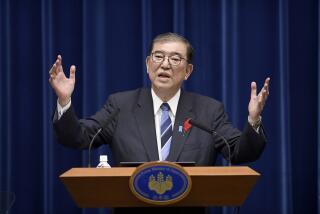A Year Later, Koizumi Loses Luster
- Share via
TOKYO — As Japanese Prime Minister Junichiro Koizumi marks his first anniversary in office today, the once-dashing figure who stormed into power with 80% popularity ratings, an open style and a sense of promise reminiscent of the early Kennedy years finds himself more and more beleaguered on all sides.
The continued confusion has implications well beyond Nagatacho, Japan’s political center. Not only does it delay the day when the world’s second-largest economy might once again pull its weight and contribute to global prosperity, but it also dashes the hopes of many ordinary Japanese that someone can lead them out of the last decade of economic, political and social difficulties.
It’s too early to write off Koizumi. A strong showing Sunday in two closely watched local by-elections could give him a much-needed boost. But increasingly, the leader once dubbed the “lion” is looking more like a house cat, just another in a long string of ineffectual Japanese leaders.
“There were such high expectations when Koizumi took over,” said Hirokazu Matsumoto, an independent political and foreign relations analyst. “Now people are hugely disappointed.”
Turning around the economy, getting a grip on a corrupt political system, banishing deeply rooted vested interests and tackling numerous social problems--to name just a few of Japan’s hurdles--would be a herculean task for any politician.
But Koizumi squandered his political capital and made key mistakes, analysts say, failing to keep his eye on the central issue affecting his supporters--the economy--even as he was increasingly diverted by Cabinet disputes and intrigue within his ruling Liberal Democratic Party, or LDP.
When he has focused on economic and financial issues, the prime minister has left some questioning the depth of his knowledge. “Koizumi doesn’t understand economics,” said independent political analyst Minoru Morita, citing the prime minister’s dogged defense of spending limits during a deep recession.
The 60-year-old bachelor leader also underestimated the importance of winning at least one significant economic reform battle early on, in order to send a signal that he meant business, keep his adversaries on the defensive and create momentum.
Instead he tried to tackle a number of issues at once--including postal reform, public works, the medical system, bloated quasi-governmental organizations and the tax system--without accomplishing much.
For a third-generation LDP politician long exposed to back-room dealing, he has also shown relatively little savvy in battling the old guard adversaries in his party--arguably his greatest enemies. Politics in any country is a messy business. But Japan--with its ingrained tradition of payoffs, slush funds and single-party rule--plays a particularly vicious game of hardball.
Analysts say it’s essential for any prime minister trying to change Japan’s archaic political culture to have a tough street fighter in his or her camp adept at fighting wily bureaucrats and entrenched politicians. Instead, Koizumi filled his Cabinet with idealists and uninspired party hacks.
The leader was also hit with some bad timing as the economy deteriorated far faster than expected after Sept. 11, emboldening old guard critics who have argued against his reforms under the pretext that more economic stimulus was the only solution.
This and growing disenchantment have eroded his support among the Japanese, who have seen unemployment rise to 5.3%, more companies go bankrupt and increases in crime rates and social instability.
“I can’t live on my pension, and have real worries about the future,” said Seiichi Sato, a 70-year-old retiree who works as a part-time security guard in Tokyo to make ends meet. “Koizumi claims he’s reforming things. You hear him saying nice-sounding words. But he’s using his mouth, not his head.”
Many observers say a turning point came with Koizumi’s handling of a visit last summer to the Yasukuni shrine, where 14 Class A war criminals are among those memorialized.
Anticipating the firestorm of disapproval from other Asian nations over his appearance at the memorial, Koizumi moved his visit up two days so it would not coincide with the Aug. 15 anniversary of Japan’s wartime surrender.
The compromise appeased almost no one, offended his conservative supporters and, more important, sent a signal that the principled man of action would bend under pressure.
“Suddenly the public and fellow politicians started to believe that Koizumi lacked a backbone,” said Hiroshi Takaku, an independent political analyst. “From then on, his political enemies were increasingly willing to engage him in a game of chicken.”
Emboldened political opponents ultimately forced him in January to sack his popular but cantankerous foreign minister, Makiko Tanaka. The result: His approval ratings were cut nearly in half, to about 40%.
Compared with previous prime ministers--poll numbers for his immediate predecessor, Yoshiro Mori, languished around 9%--Koizumi still enjoys relatively strong popular appeal. And it’s not too late for him to regain traction, analysts say.
But he needs to move quickly, they say, by convincing ordinary Japanese that he has a blueprint for the future.
A cartoon in Thursday’s daily Asahi Shimbun newspaper shows Koizumi sweating profusely on a treadmill as his political rivals watch gleefully through a window.
“That about describes it,” said Naoto Matsuda, a 49-year-old office worker in Tokyo. “He’s putting lots of effort into going forward. But he’s the only one who thinks he’s getting anywhere.”
*
Rie Sasaki in The Times’ Tokyo Bureau contributed to this report.
More to Read
Sign up for Essential California
The most important California stories and recommendations in your inbox every morning.
You may occasionally receive promotional content from the Los Angeles Times.













